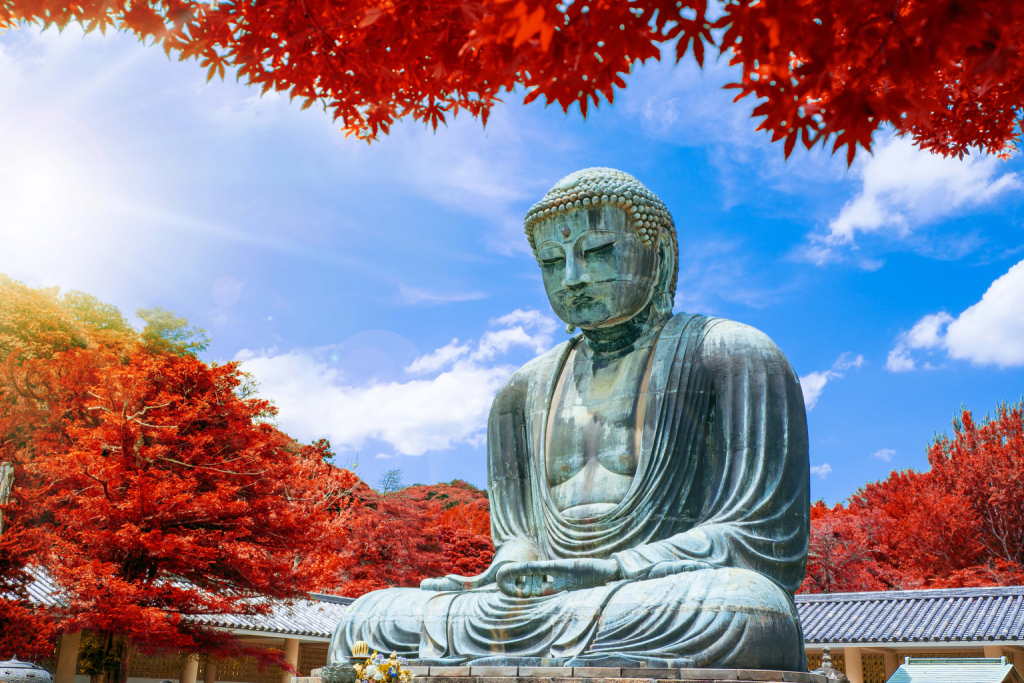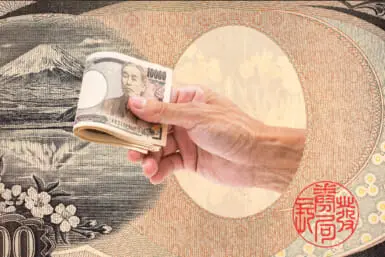Autumn is one of the best seasons to visit Kanagawa Prefecture to witness stunning displays of red, orange and yellow autumn leaves. It’s easily accessible by train from Tokyo, making it perfect for a day trip. Hakone, known for its hot springs, and Kamakura, known for its temples and shrines, are two of the most popular tourist destinations. Kanagawa is also home to Yokohama, the second largest city in Japan with a population of around 3.8 million. All of these places offer stunning autumn foliage. Here are our 13 picks.
Yokohama

Sankeien Garden in Yokohama, Kanagawa Prefecture
1. Sankeien Garden
The sprawling garden which covers 175,000 square meters features several buildings, including a three-story pagoda from Kyoto, historical teahouses and a former feudal lord’s residence. In autumn, ginkgo and maple trees transform the garden thanks to the vibrant red and yellow colors. The Choshukaku tea house, built especially for viewing autumn leaves, provides a peaceful space to view the deep red of the maple leaves.
Best time to go: Mid-November to mid-December
2. Nihon Odori Avenue
Designed by Richard Henry Brunton and completed around 1870, the first western-style street in Japan is lined by beautiful yellow ginkgo leaves every autumn. Visitors can admire the leaves against the backdrop of historical buildings such as the Kanagawa Prefectural Government Office and Yokohama Archives of History. They can also sit in open-air cafés and take in the cool autumn breeze while admiring the leaves.
Best time to go: Mid-November to mid-December
Hakone

Lake Ashi
3. Lake Ashi
The largest lake in Kanagawa, Lake Ashi is the perfect place to admire autumn foliage with a breathtaking view of Mount Fuji. Since it’s surrounded by mountains and forests, visitors can observe different colors at different altitudes in a serene, picturesque landscape.
Best time to go: Late October to mid-November

Hakonekomagatake Ropeway
4. Hakone Komagatake Ropeway
Hakone Komagatake Ropeway is one of two ropeways in Hakone that take visitors up to see a stunning view of Mount Fuji, the surrounding forest and the Pacific Ocean. Visitors can admire a sea of autumn colors through the windows of the cable car and at the Hakone Shrine Mototsumiya.
Best time to go: Late October to mid-November
5. Hakone Museum of Art
The oldest museum in Hakone is home to brilliant red and yellow autumn leaves in its 1,900 square meter moss garden. The approximately 130 types of moss and 200 red and yellow trees create a stunning view. The museum itself is excellent, making for a well-rounded visit.
Best time to go: Late October to mid-November

Hakone Gora Park
6. Hakone Gora Park
This is a symmetrical, French-style garden home to greenhouses, a rose garden, teahouse, crafthouse and a large fountain. Famous for June hydrangeas, this park has something to wow visitors every season. The maple trees paint the landscape in bright red every autumn, creating a relaxing environment for a stroll along the garden’s paths.
Best time to go: Late October to mid-November
Kamakura

Hasedera
7. Hasedera
While visitors can come during the daytime, the special night-time admission at Hasedera makes it a must-see spot in the fall. Usually, temples like this are closed at night, but Hasedera allows visitors inside during the peak season of fall foliage to witness lit-up buildings and autumn leaves, so it’s a rare opportunity to see the beauty of the temple at night.
Best time to go: Late November to early December

Tsurugaoka Hachimangu Shrine
8. Tsurugaoka Hachimangu Shrine
As the most important shrine in Kamakura in the cultural heart of the city, this place of worship and beauty alone is worth a visit any time of the year. In autumn, witnessing the leaves changing colors provides an added layer of magic. The shrine is conveniently located just a ten-minute walk from Kamakura Station.
Best time to go: Late November to early December
9. Zuisenji Temple
Located in the back of a narrow valley and surrounded by wooded hills, Zuisenji Temple is known for its Zen rock garden designed by Muso Kokushi (also known as Muso Soseki), a leading Zen master and one of Japan’s most famous garden designers. Surrounded by the calm forest and its colorful foliage, visitors can feel the serene nature of the landscape.
Best time to go: Late November to early December
Other Spots

Lake Tanzawa
10. Lake Tanzawa (Yamakita)
Visitors can admire Mount Fuji and Lake Tanzawa surrounded by red, yellow and orange autumn leaves from the observatory deck located in Chiyosawa Park. The lake was created during the construction of the Miho Dam. It’s known as one of the 50 scenic spots in Kanagawa.
Best time to go: Mid- to late November

Oyama-Afuri Shrine. Photo by bondjb via Shutterstock.com.
11. Oyama Afuri Shrine (Mount Oyama)
This ancient shrine, said to have been built 2,000 years ago, features beautiful autumn foliage. Visitors can either walk up or take a cable car. The views of the skyline from the peak are especially breathtaking during sunset when the fiery autumn leaves are showered by the sun rays.
Best time to go: Mid- to late November

Ikuta Ryouichi Park. Photo by J_Valencia via Shutterstock.com.
12. Ikuta Ryokuchi Park (Kawasaki)
This park is the perfect location to view seasonal changes of nature including sakura in spring, irises in early summer and, of course, autumn foliage in fall. In addition to admiring the autumn foliage, visitors can also stroll through the Rose Garden, which is only open during spring and autumn. Combine your park visit with a visit to these nearby museums: Taro Okamoto Museum of Art, the Fujiko F Fujio Museum and the Kawasaki Municipal Science Museum planetarium.
Best time to go: Mid-November to mid-December

Lake Shinsei
13. Lake Shinsei (Hadano)
Lake Shinsei is the newest natural lake in Japan, since it was created in 1923 by the Great Kanto earthquake. It’s best to go on a hike through the surrounding forest in autumn. Reaching the lake, visitors can immerse themselves in the beauty of the autumn foliage in contrast to the blue waters.
Best time to go: Late November to early December









